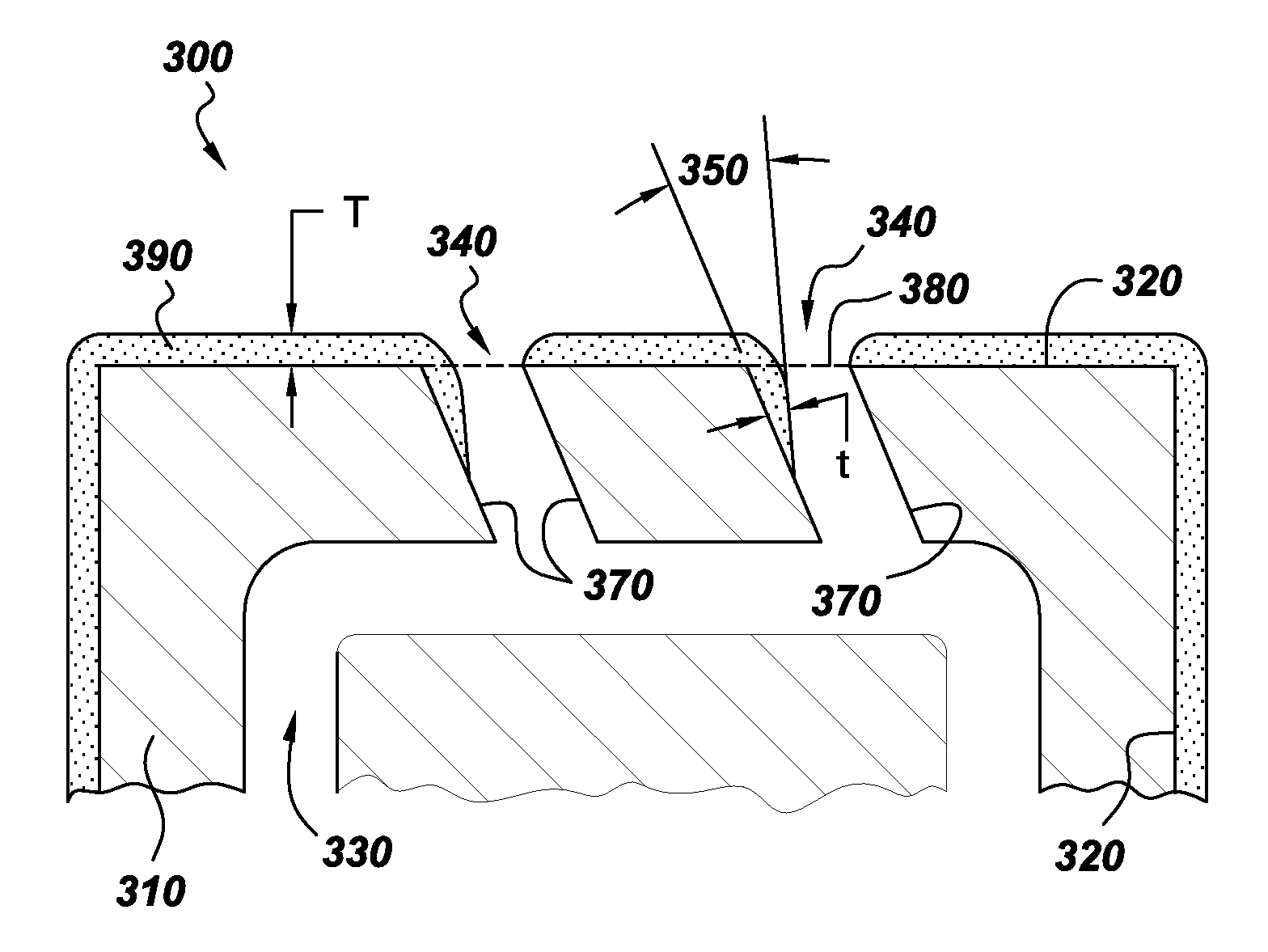Articles for high temperature service and methods for their manufacture
a technology of high temperature service and manufacturing methods, applied in the direction of wind motors with parallel air flow, wind motors with perpendicular air flow, liquid fuel engine components, etc., can solve the problems of clogging of cooling holes and more expensive pvd techniques to adhere to critical cooling hole flow specifications
- Summary
- Abstract
- Description
- Claims
- Application Information
AI Technical Summary
Benefits of technology
Problems solved by technology
Method used
Image
Examples
example 1
[0025]An yttria-stabilized-zirconia (YSZ) coating was produced on a nominal 1.6 millimeter thick plate of a cobalt-based superalloy substrate using a Mettech Axial III DC plasma torch. Prior to coating deposition, the substrate was laser drilled to obtain 10 rows of 10 through holes each of nominally 508 micron (0.020 inch) diameter at an angle of 30 degrees relative to the top surface of the plate. Each laser drilled hole was spaced approximately 3 mm from an adjacent hole. The plate was deburred and abrasive blasted using 220 mesh aluminum oxide prior to coating. The feedstock material used to produce the coating was an 8 wt % YSZ powder with a d50 of 0.4 mm suspended in ethanol at 10 wt % using polyethyleneimine as a dispersant (at 0.2 wt % of the solids). The suspension was injected into the plasma torch through the center tube of a tube-in-tube atomizing injector with a nitrogen atomizing gas sent through the outer tube. The torch power was about 90 kW using an electrode curren...
example 2
[0027]As in example 1, a YSZ coating was deposited onto a similarly prepared laser drilled cobalt alloy plate. Feedstock was the same as in example 1. Plasma parameters used to produce coatings in this example were a total torch power of 90 kW obtained using an electrode current of 200 amps per electrode and a total plasma gas flow of 245 slpm consisting of 75% argon, 10% nitrogen, and 15% hydrogen. The plasma torch was rastered across the substrate at 600 mm / sec while maintaining a constant spray distance of 76 mm distance between the torch nozzle and substrate. An average coating thickness of 100 micrometers was obtained on the top surface of the plate. As in example 1, a tapered coating profile was produced from the top coated surface extending into the holes. The coating thickness measured at the throat threshold of the hole was 4% of the channel diameter.
example 3
[0028]Plasma parameters were the same as in example 2, except that a spray distance of 50 millimeters was used. An average coating thickness of 140 micrometers was obtained on the top surface of the plate. As in examples 1 and 2, a tapered coating profile was produced from the top coated surface extending into the holes. The coating thickness measured at the throat threshold of the hole was 9% of the channel diameter.
PUM
| Property | Measurement | Unit |
|---|---|---|
| Fraction | aaaaa | aaaaa |
| Fraction | aaaaa | aaaaa |
| Fraction | aaaaa | aaaaa |
Abstract
Description
Claims
Application Information
 Login to View More
Login to View More - R&D
- Intellectual Property
- Life Sciences
- Materials
- Tech Scout
- Unparalleled Data Quality
- Higher Quality Content
- 60% Fewer Hallucinations
Browse by: Latest US Patents, China's latest patents, Technical Efficacy Thesaurus, Application Domain, Technology Topic, Popular Technical Reports.
© 2025 PatSnap. All rights reserved.Legal|Privacy policy|Modern Slavery Act Transparency Statement|Sitemap|About US| Contact US: help@patsnap.com



